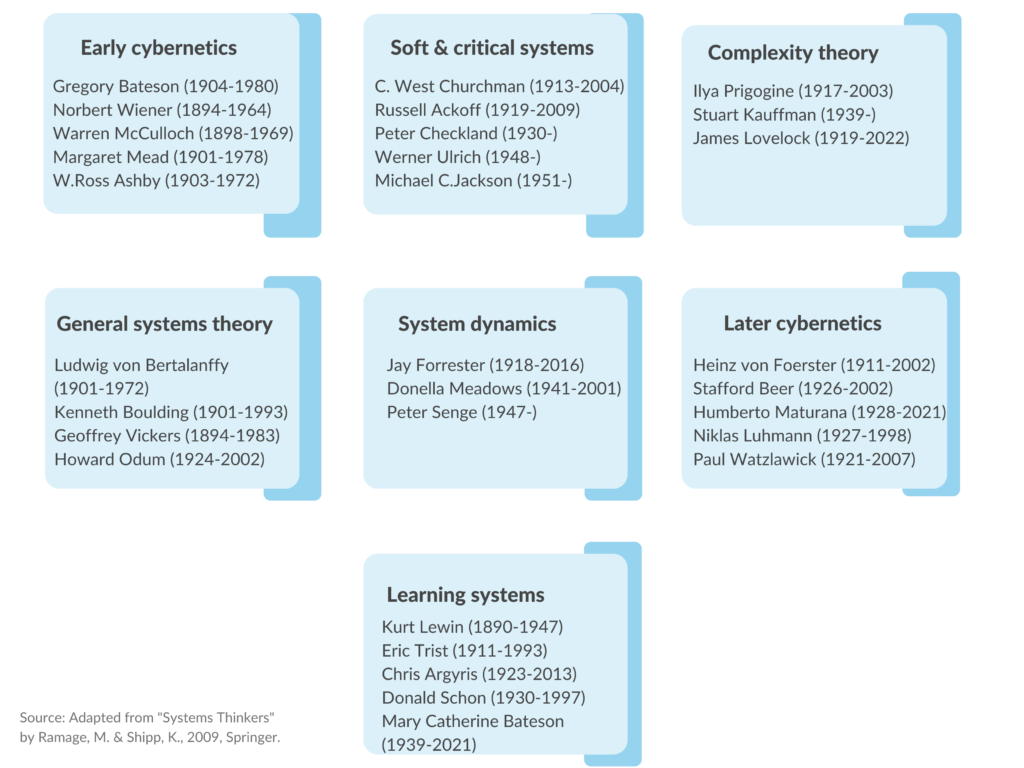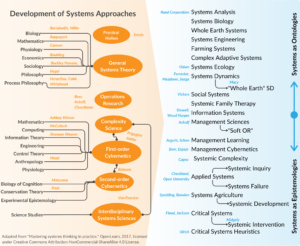The field of systems thinking is vast and complex, with many brilliant minds contributing to its history over the years. The sheer volume of work and the diverse range of viewpoints involved makes it difficult to draw any clear boundaries around the field.
Our approach involves taking a broad perspective and emphasizing the crucial contributors and milestones that have advanced the movement. One potential drawback of concentrating on a particular level of detail is the possibility of overlooking certain facets of history, including potentially significant ones. Our primary objective is to offer foundational knowledge for those looking to explore the history and development of systems movement. This entails understanding the evolution, notable figures, and important milestones.
Tektology by Alexander Bogdanov: A forerunner to systems theory
Although Ludwig von Bertalanffy is widely recognized as the founding father of systems theory, Alexander Bogdanov (1873 – 1928), a Russian medical researcher, philosopher, and economist, developed an equally sophisticated and comprehensive systems theory two to three decades before Bertalanffy published his “General Systems Theory (GST)”. Unfortunately, Bogdanov’s work is relatively unknown outside of Russia.
Derived from the greek word “Tekton,” meaning “Builder,” Alexander Bogdanov referred to his theory as “tektology,” or “the science of structures”. Tektology was the first attempt in the history of science to arrive at a systematic formulation of the principles of organization operating in living and nonliving systems (Capra & Luisi, 2014).
“Tektology deals with organizational experience not of this or that specialized field, but of all these fields together. In other words, tektology embraces the subject matter of all the other sciences and of all the human experience giving rise to these sciences, but only from the aspect of method, that is, it is interested only in the modes of organization of this subject matter.”
(Bogdanov 1922, quoted by Gorelik in Bogdanov’s Tektology, General systems theory and cybernetics.)
General Systems Theory (GST) by Ludwig von Bertalanffy
In the west, Ludwig von Bertalanffy (1901- 1972) is generally recognized as the father of General Systems Theory (GST), he first Introduced the concept in 1937 at the University of Chicago.
Ludwig von Bertalanffy’s philosophy of system thinking has revolutionized the way we understand complex phenomena. According to him, if we shift our focus to viewing the world as an organized whole and recognize the interconnectedness and interdependence of all things, we can begin to comprehend the nature of reality in a more comprehensive manner. With its roots in biology, Bertalanffy’s system philosophy aims to identify universal principles that apply to all types of systems, regardless of whether they are physical, biological, or social (Capra & Luisi, 2014) (Jackson, 2022) . This approach promotes the unity of science and encourages the recognition of isomorphisms between different kinds of systems.
His most groundbreaking contribution is the conception of living systems as open systems, which are dynamic and ever-changing and exist far from equilibrium (Hammond, 2023) .
Overall, Bertalanffy’s philosophy of systems thinking has significantly influenced research, practice, and theory across a diverse range of fields and continues to inspire new ways of understanding the world around us.
Also Read : Russell Ackoff: A Visionary in Systems Thinking
The Society for General Systems Research (SGSR)
In collaboration with Kenneth Boulding, James Miller, Rapp Gerald, and Anatol Rapoport, Ludwig von Bertalanffy established the Society for General Systems Research (SGSR) in 1954 at the Centre of Advance Study in the Behaviour Sciences (CASBS) at the Stanford University.
According to Hammond (2003), SGSR’s main philosophy aimed to achieve four primary objectives.
- Investigate the isomorphy of concepts, laws, and models in various fields, and to help in useful transfers from one field to another;
- Encourage the development of adequate theoretical models in the fields which lack them;
- Minimize the duplication of theoretical effort in different fields;
- Promote the unity of science by improving communication among specialists.
In 1988, the organization’s name was changed to the International Society for the Systems Sciences (ISSS), and it remains active to this day.

Lead with Innovation
Systems Thinking training prepares you to lead in a complex world.
Cybernetics, the science of control and communication
Norbert Wiener (1894 – 1964), a mathematician, philosopher, and computer scientist, coined the term “cybernetics” in 1946, drawing inspiration from the greek word kybernetes (latin equivalent, gubernator) meaning “governor” in the sense of “steersman”, so one could read “cybernetics” as “the science of steersman ship”.
Wiener envisioned cybernetics as humanity’s conquest into the digital age, as governments, universities, and companies were all racing to take advantage of recent innovations.
His creation of the term “cybernetics” reflected his belief that humans could control technical systems as they unfolded, and as computing power expanded, the world would become a new kind of feedback loop – not just mechanical, but a biomechanical one involving computers, humans, and the environment.
The Macy Conferences: A historical milestone in the development of cybernetics and systems thinking
The Macy Conferences, held in New York between 1946 and 1953 and organized by Warren McCulloch and the Josiah Macy, Jr. Foundation, aimed to bring together scholars from various academic disciplines in order to better understand the functioning of the human mind. These conferences laid the groundwork for the birth of both cybernetics and systems theory.
The outcomes of these discussions were instrumental in the development of artificial intelligence, computer science, and systems theory. The Macy Conferences were an important milestone in history, introducing groundbreaking ideas that continue to shape our world today.
Also Read : Jay Wright Forrester: The mastermind behind system dynamics
The complexity theory
In the realm of science, complexity theory stands as a revolutionary approach to modelling complex systems that has garnered significant attention over the last few decades. Drawing inspiration from General Systems Theory (GST) and cybernetics, complexity theory employs techniques derived from physical sciences and is characterized by its focus on self-organisation, emergence and nonlinearity.
Complexity theory encompasses three distinct strands: chaos theory, the theory of dissipative structures, and the study of complex adaptive systems.
In understanding the dynamics of organizational life, complexity theory offers a fresh perspective that challenges traditional notions of structure and order. By emphasizing the importance of disorder, irregularity, and randomness, this theoretical framework highlights the complexity of human interactions and behavior within organizations. While these aspects of organizational life have largely been ignored in the literature, complexity theory asserts that they are critical to understanding how organizations function and change over time. By embracing the chaotic and unpredictable nature of organizational life, complexity theory offers a more comprehensive and nuanced approach to organizational analysis that can help us better navigate the challenges and opportunities of our complex and rapidly changing world.
Embracing the challenge of organized complexity through systems sciences
Warren Weaver’s essay “Science and Complexity,” published in 1948, greatly impacted the development of systems sciences. By distinguishing between organized simplicity, unorganized complexity, and organized complexity, Weaver enabled a better understanding of the varying types of systems and the categories in which they fall.
When it comes to analyzing systems that involve a few variables and are predictable, deterministic, and simple, the classical mathematical tools of calculus and differential equations are the go-to solutions. This problem yields to the concept of “organized simplicity”. One example of such a system is Newtonian mechanics. By breaking down the system into its constituent parts and applying these mathematical tools, we can gain a deeper understanding of its behaviour and predict its outcomes. This concept is particularly useful in the region of machines or mechanisms.
“Unorganized complexity”: refers to a vast number of components exhibiting a high degree of unpredictability, complexity, and randomness. This phenomenon occurs in populations or aggregates, resulting in intricate patterns that can be difficult to unravel. Fortunately, statistics and probability theory can help tame unorganized complexity. One of the most famous examples of this is the equation of thermodynamics, which provides a framework for understanding how energy behaves in complex systems. By using mathematical tools to analyze data, scientists can gain insight into seemingly chaotic systems and make predictions about their behavior. Despite its challenges, unorganized complexity presents an exciting opportunity to explore the underlying principles that guide complex systems, leading to new discoveries and breakthroughs in science and beyond.
“Organized complexity” is a region too complex for analysis and too organized for statistics. It’s the realm of problems that demand us to handle a significant number of interrelated factors that form a holistic whole. Organized complexity presents a wide range of challenges, encompassing inquiries into the conduct of organized social entities, elucidation of the conduct of living organisms, and the establishment of monetary stability. This is the regions of systems. According to Mike Jackson, It is this challenge that the systems sciences have embraced in the form of general systems theory, cybernetics, and complexity theory.
Also Read : Donella Meadows’ Pioneering Contributions to Systems Thinking and Environmental Advocacy
Conclusion
The field of systems thinking has undergone significant evolution and is now emerging as one of the most impactful ways to manage the complexities of today’s world. Systems thinking provides organizations with a diverse range of methods and approaches to gain valuable insights and effectively tackle systemic issues.
Systems thinking has certainly come a long way since its inception, and its evolution is too extensive to be covered entirely in a single blog post. However, we can leave you with two essential artifacts that shed light on this fascinating field.
- The first one is Magnus Ramage and Karen Shipp’s book, “Systems Thinkers”, which brilliantly covers all the major contributors and groups them based on their key systems approaches. This book is a must-read for anyone interested in gaining an in-depth understanding of systems thinking and serves as an invaluable resource for those seeking to understand the evolution of systems thinking over time.

- The second artifact is an image offered by the open university that explains the various influences that have shaped the field of systems thinking and the lineages from which they have emerged. This image is an excellent visual representation of systems thinking and its evolution over the years.

By examining these two artifacts, we can obtain valuable insights into the field of systems thinking. Collectively, they provide a holistic view of the development and breakthroughs achieved in systems thinking.


